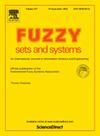对称Wajsberg伪环的表示
IF 2.7
1区 数学
Q2 COMPUTER SCIENCE, THEORY & METHODS
引用次数: 0
摘要
本文探讨了由有界Wajsberg伪圈滤波器衍生的Wajsberg伪圈,也称为伪v -代数。推广了[1]关于每个Wajsberg环是一个v -代数的极大滤波器的已知结果,引入了对称Wajsberg伪环作为包含Wajsberg环的一种变体。我们证明了一个有界Wajsberg伪环的每一个正规滤波器都是一个合适的有界Wajsberg伪环的超滤波器。在Wajsberg伪环上引入一种新的二元操作,重点讨论对称Wajsberg伪环。我们证明了每个环H与Wajsberg伪环a (H)的滤波器诱导的伪环是同构的,并且a (H)在同构上是唯一的。通过分析H和A(H)的正规素数(极大)滤波器之间的关系,建立了它们的可表示性的充分必要条件,加深了对这些代数系统结构性质的认识。本文章由计算机程序翻译,如有差异,请以英文原文为准。
A representation of symmetric Wajsberg pseudo hoops
This paper explores Wajsberg pseudo hoops derived from filters of bounded Wajsberg pseudo hoops, also known as pseudo MV-algebras. Extending the known result from [1] that every Wajsberg hoop is a maximal filter of an MV-algebra, we introduce symmetric Wajsberg pseudo hoops as a variety encompassing Wajsberg hoops. We demonstrate that every normal filter of a bounded Wajsberg pseudo hoop is an ultrafilter of an appropriate bounded Wajsberg pseudo hoop. Introducing a new binary operation ⊛ on Wajsberg pseudo hoops, we focus on symmetric Wajsberg pseudo hoops. We establish that each such hoop H is isomorphic to the pseudo hoop induced by a filter of a Wajsberg pseudo hoop , with unique up to isomorphism. By analyzing the relationship between normal prime (maximal) filters of H and , we establish a necessary and sufficient condition for their representability, deepening the understanding of the structural properties of these algebraic systems.
求助全文
通过发布文献求助,成功后即可免费获取论文全文。
去求助
来源期刊

Fuzzy Sets and Systems
数学-计算机:理论方法
CiteScore
6.50
自引率
17.90%
发文量
321
审稿时长
6.1 months
期刊介绍:
Since its launching in 1978, the journal Fuzzy Sets and Systems has been devoted to the international advancement of the theory and application of fuzzy sets and systems. The theory of fuzzy sets now encompasses a well organized corpus of basic notions including (and not restricted to) aggregation operations, a generalized theory of relations, specific measures of information content, a calculus of fuzzy numbers. Fuzzy sets are also the cornerstone of a non-additive uncertainty theory, namely possibility theory, and of a versatile tool for both linguistic and numerical modeling: fuzzy rule-based systems. Numerous works now combine fuzzy concepts with other scientific disciplines as well as modern technologies.
In mathematics fuzzy sets have triggered new research topics in connection with category theory, topology, algebra, analysis. Fuzzy sets are also part of a recent trend in the study of generalized measures and integrals, and are combined with statistical methods. Furthermore, fuzzy sets have strong logical underpinnings in the tradition of many-valued logics.
 求助内容:
求助内容: 应助结果提醒方式:
应助结果提醒方式:


